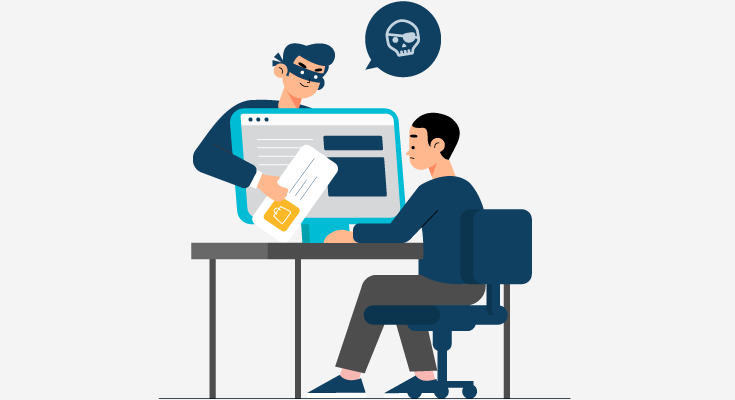First-Party Fraud, and How To Prevent It?

The word fraud is used almost every day today. It’s not always hackers sitting behind multiple screens who conduct these frauds. Ordinary people with a little bit of knowledge also conduct fraud. In reality, a lot of customers end up sharing their personal information with fraudsters unknowingly. These fraudsters use this information to rack up huge credit card bills. In other cases, users end up committing fraud using their own information.
Both of these types of fraud are called first-party fraud.
Most of us assume that first-party fraud happens only in banks, but as telecom companies have entered the financial industry, so they’re also feeling the pinch. Debt collection agencies are leaking more profits and costs, trying to collect something that isn’t recoverable.
First-Party Fraud Affects Profitability
First-party fraud usually comprises 10% of the volume of credit card losses. These losses are also called bad debts. This huge risk often gets missed as it comes somewhere between the risk department, operations, and the fraud team. In other words, first-party fraud does not have an owner most of the time.
Soiled fraud and collection departments can reduce the chances for fraudulent patterns to be discovered. While the relatively low volume of first-party fraud reduces its priority level, for some organizations, first-party fraud remains one of the biggest profit drains.
In 2022, it is more vital than ever to take decisive actions and manage first-party fraud.
Why It’s Easy to Miss First-Party Fraud?
Traditional third-party fraud requires some kind of impersonation or stolen identity. Be it stolen credit card data, or someone taking over your identity. At some point, many victims of third-party fraud become aware of the crime when unknown transactions come up on their statements.
Compared to third-party fraud, first-party fraud is often confused with credit risk problems. Accounts that don’t pay their debts are sent to collections for a progression of treatment.
Unlike third-party fraud, the transactions happen with accurate information and they look like legit transactions. This makes first-party fraud much harder to spot. And in this way, first-party fraud can be eventually written off as it is uncollectible. This information is also sold to third-party external collection agencies.
Newer financial services providers are even more challenged in figuring out first-party fraud. Newcomers don’t have access to all the historical data that banks have to analyze which transactions are legit and which aren’t.
Be it an online bank, or a telecom service financing costly devices, all these organizations face similar challenges in fraud prevention.
Common Types of First-Party Fraud
There are different types of first-party frauds that organizations should know about:
- Sleeper Fraud: It occurs when a fraudster gets their hands on a type of credit, and over time builds up a reputation. As they build trust with the service provider over months, they can take maximum advantage of cash and any goods with these cards. Once they’ve racked up a huge debt, they leave this information and move on to the next one.
- Bust-Out Fraud: This type of fraud is also called hit-and-run fraud. It can happen in a type of financial service. It’s quick and sometimes easy, and credit cards and loans are the easiest targets. In some countries where cheques are in use or have slower clearing cycles, fraudsters can exploit these weaknesses to rack up a credit balance 10 times the normal limit. Then the fraudsters cash out before these transactions are even caught.
How Does First Party Fraud happen?
First-party fraud is highly opportunistic and it can be done on a small scale by a single fraudster or by a group of fraudsters. Both sleeper fraud and bust-out fraud can be conducted in an opportunistic fashion.
Some of the first-party fraud schemes are executed in both ways. For example, in the UK, Europe, and the Middle East, the highly fluid mobility of university students creates conditions that are perfect for fraud.
In this type of fraud, fraudsters gangs have focused on out-of-country students to buy their ID data and bank account information as these students go back to their home countries. There are many potential victims, as only 10% of foreign students stay in their country. Almost 90% of students go back to their home countries, thus their information is ripe for exploitation.
Fraud with student credential fraud often starts with criminal gangs advertising in student unions and social media. Sometimes they even infiltrate family WhatsApp groups just to get their hands on some quick cash.
While these offers may be tempting to cash-strapped students, the fraudsters have different intentions. With 1.3 million students in the EU, you can see why this group is one of the biggest targets for fraudsters.
Strategies for Fighting First-Party Fraud
The biggest challenge with first-party fraud is distinguishing between fake and real customers. So, what can businesses do? Here are some strategies to try fighting first-party fraud:
- Learn to recognize the distinction between unintentional bad debt and intentional bad debt, or fraud. With the right type of analytics, patterns can start to become clear, and very evident.
- You need to accurately categorize fraud as fraud, instead of calling it a bad debt. These instances should be called first-party fraud or synthetic identity fraud. This will help you to begin identifying patterns and common traits in the schemes fraudsters use.
- Define clear rules and models and perform link analysis to analyze data for known fraud patterns. These common signs include phone numbers, names, email addresses, and other identifiers that fraudsters will use again and again to apply for loans, credit cards, accounts, and mobile subscriptions.
- Improve sign-up and onboarding processes by using these analytics. By doing this, you can monitor for links between declined applications for credit risk and new applications where the same data is used for application.
- If you don’t have enough evidence to mark a transaction as fraudulent, tag these accounts as suspicious accounts. Once an account is opened, and credit is extended, the account can be monitored more carefully for suspicious activity. Any sudden changes in account data can be a sign of fraudulent transactions about to happen.
Be Proactive With First Party Fraud
The rate of fraud is only increasing, so businesses need to be proactive in fraud prevention. For those fraudsters with established synthetic identities hidden in account portfolios, the high time for using these identities is now.
At the same time, organizations that are keen to increase their customer base have had to increasingly look to digital channels, as face-to-face interactions have almost vanished. Increased criminal activity coupled with increased reliance on remote onboarding processes has made it harder to prevent fraud.
Businesses need to make sure that they act before fraudsters do.













